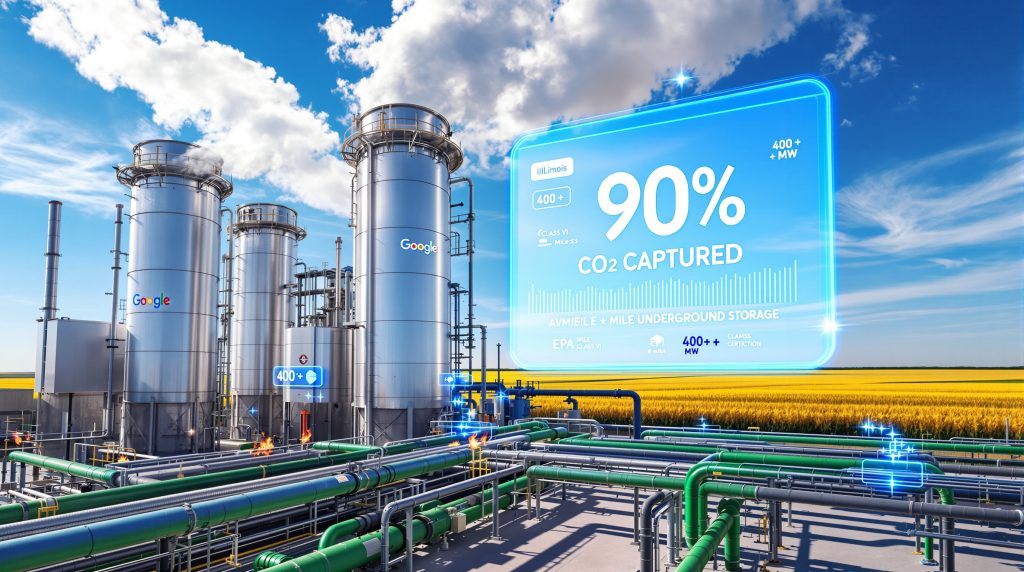Google's Revolutionary Approach to Clean Energy Infrastructure
Google has announced a groundbreaking partnership that positions the tech giant at the forefront of innovative energy procurement strategies. The company will become the first major corporation to purchase electricity generated from natural gas plants equipped with advanced carbon capture and sequestration technology, marking a pivotal shift in how technology companies address their growing energy demands while maintaining environmental commitments.
This initiative represents a strategic response to the unprecedented power requirements of artificial intelligence and cloud computing operations, which demand consistent, reliable electricity that traditional renewable sources cannot yet provide at scale. The partnership with energy developers signals a new era where corporations actively invest in bridging technologies that combine fossil fuel reliability with carbon reduction capabilities.
Understanding Carbon Capture Technology in Power Generation
The Technical Foundation of Carbon Sequestration
Carbon capture and sequestration technology fundamentally transforms conventional natural gas power generation by intercepting carbon dioxide emissions before they reach the atmosphere. This process involves three critical phases: capturing CO₂ at the point of combustion, compressing and transporting the gas through specialised pipeline networks, and permanently storing it in deep geological formations.
Modern carbon capture systems achieve capture rates exceeding 90% of total emissions produced during natural gas combustion. The captured carbon dioxide undergoes compression and injection into EPA-approved Class VI wells, located more than 5,000 feet below ground in stable rock formations that have been geologically proven to contain CO₂ for millennia.
Performance Metrics and System Specifications
The technology relies on post-combustion capture methods that separate CO₂ from flue gases using chemical solvents or solid sorbents. These systems operate continuously, monitoring gas compositions and adjusting capture efficiency in real-time to maintain optimal performance standards.
| System Component | Performance Specification |
|---|---|
| CO₂ Capture Rate | >90% of total emissions |
| Storage Depth | 5,000+ feet underground |
| Monitoring Duration | Continuous for decades |
| Storage Security | 1,000+ year containment |
| Pipeline Pressure | 1,500-2,200 psi |
Transportation infrastructure includes high-pressure pipelines designed specifically for CO₂ transport, with materials and engineering standards that prevent leakage and ensure safe delivery to storage sites. Monitoring systems track pipeline integrity through sensor networks that detect pressure variations, temperature changes, and potential leak indicators.
The Energy Challenge Driving Tech Industry Innovation
AI Operations and Power Reliability Requirements
Artificial intelligence workloads impose extraordinary demands on electrical infrastructure that distinguish them from traditional computing applications. Machine learning model training and inference operations require massive parallel processing capabilities that cannot tolerate power interruptions, voltage fluctuations, or supply inconsistencies.
Data centres supporting AI applications typically operate at power densities exceeding 50 kilowatts per rack, compared to 6-10 kilowatts for conventional servers. These facilities require power availability ratings of 99.99% or higher, meaning acceptable downtime measures in minutes per year rather than hours or days.
Renewable Energy Limitations in Industrial Applications
While renewable energy sources provide environmental benefits, their inherent variability creates operational challenges for energy-intensive industrial processes. Furthermore, the uranium market volatility has highlighted how traditional energy sources face their own supply chain challenges.
Solar photovoltaic systems generate zero electricity during nighttime hours and experience significant output variations due to cloud cover, seasonal changes, and weather patterns.
Renewable Energy Constraints:
- Solar generation ceases completely after sunset
- Wind output varies by 70-80% based on atmospheric conditions
- Hydroelectric capacity fluctuates with seasonal water availability
- Battery storage remains economical for 2-6 hour duration periods
- Grid-scale storage costs range from $150-300 per megawatt-hour
Google backs carbon-captured gas as a solution that offers significant advantages:
- 24/7 baseload power generation capability
- >90% emission reduction versus conventional natural gas
- Immediate scalability using existing infrastructure
- Load-following capability to match demand fluctuations
- Integration potential with renewable energy systems
Current battery technology costs and duration limitations prevent renewable sources from providing the reliable, long-duration power supply required for continuous industrial operations. Lithium-ion battery systems optimised for grid applications typically provide 4-8 hours of storage duration, insufficient for multi-day renewable energy gaps.
The Broadwing Energy Project: Technical Specifications
Project Infrastructure and Capacity
The Broadwing Energy facility will feature a 400+ megawatt natural gas cogeneration plant strategically positioned in Decatur, Illinois, on existing Archer Daniels Midland industrial property. This location provides access to established CO₂ storage infrastructure that ADM has operated for over a decade through their ethanol production processes.
In addition to this innovative approach, the broader energy landscape is evolving as Google's carbon capture investment demonstrates the tech giant's commitment to bridging solutions while conventional energy markets experience their own transitions.
Cogeneration technology maximises energy efficiency by simultaneously producing electricity and industrial steam from the same natural gas input. This configuration typically achieves overall system efficiencies of 65-80%, compared to 35-45% for conventional power generation that wastes heat energy.
Strategic Location Benefits
The Decatur site offers unique advantages that reduce project development costs and timeline risks. However, recent developments in global energy markets, including the US Senate ban on Russian uranium imports, have highlighted the importance of diversified energy strategies.
ADM's existing CO₂ pipeline networks and proven geological storage formations eliminate the need for extensive new infrastructure development.
Infrastructure Advantages:
- Operational CO₂ injection wells and monitoring systems
- Established natural gas transmission pipeline connections
- Existing electrical transmission and distribution access
- Industrial zoning and environmental permits in place
- Skilled workforce experienced in industrial operations
Economic Benefits:
- Reduced capital expenditure through infrastructure sharing
- Accelerated project timeline using proven storage methods
- Lower operational costs through economies of scale
- Enhanced project viability through demonstrated technology
- Shared monitoring and maintenance infrastructure
The geological formations beneath the Decatur site consist of deep saline aquifers within the Mount Simon Sandstone formation, which has been extensively characterised for CO₂ storage capacity and containment properties. These formations have successfully stored millions of tons of carbon dioxide from ADM's ethanol operations without leakage or environmental impacts.
Global Carbon Capture Technology Landscape
International CCS Deployment Strategies
Carbon capture technology deployment varies significantly across global markets, reflecting different energy policies, geological conditions, and economic frameworks. Each region has developed distinct approaches based on local resources and strategic priorities.
Norway's CCS Leadership:
Norway operates the world's longest-running commercial CCS projects, including the Sleipner field which has stored over 20 million tons of CO₂ since 1996. The Norwegian government provides direct financial support for industrial CCS development and has established the Northern Lights project to provide shared CO₂ transport and storage services for European industries.
Canada's Oil Sands Integration:
Canadian CCS projects focus primarily on oil sands operations and enhanced oil recovery applications. The Quest project in Alberta captures approximately 1 million tons of CO₂ annually from Shell's Scotford upgrader operations. Provincial governments provide investment tax credits and regulatory frameworks specifically designed for CCS deployment.
Australia's Research Focus:
Australia has invested heavily in CCS research and development through government-industry partnerships. The Gorgon project incorporates carbon capture as part of liquefied natural gas operations, though technical challenges have limited its effectiveness compared to design specifications.
Competitive Corporate Energy Strategies
Technology companies are pursuing diverse approaches to address their growing energy demands while meeting carbon reduction commitments. These strategies reflect different risk tolerances, operational requirements, and regional energy market conditions.
| Company | Primary Strategy | Scale | Implementation Timeline |
|---|---|---|---|
| CCS + Natural Gas | 400+ MW | 2029-2032 | |
| Microsoft | Renewable + Storage | 2,000+ MW | Ongoing |
| Amazon | Wind + Solar Portfolio | 3,000+ MW | 2025-2030 |
| Meta | Renewable PPAs | 1,500+ MW | 2026-2028 |
Economic Analysis of Carbon-Captured Gas Technology
Capital Cost Structure and Investment Requirements
Carbon capture technology significantly increases upfront capital costs for natural gas power generation projects. Industry analyses suggest CCS systems add 35-65% to total project costs compared to conventional natural gas plants, depending on capture technology selection and storage infrastructure requirements.
Major Capital Cost Components:
- CO₂ capture equipment installation: $400-600 per kilowatt
- Compression and transportation infrastructure: $50-100 per kilowatt
- Deep well drilling and completion: $3-8 million per well
- Enhanced monitoring and safety systems: $10-25 million per project
- Extended construction timeline costs: 12-24 month delay penalties
Operational Cost Implications:
- Plant efficiency reduction of 8-15% due to capture energy requirements
- Increased natural gas consumption of 15-25% per unit of electricity generated
- Water usage increases of 40-60% for CO₂ processing systems
- Auxiliary power requirements consuming 10-20% of plant output
Revenue Opportunities and Financial Incentives
The federal 45Q tax credit provides significant financial support for carbon capture projects, offering up to $85 per metric ton for CO₂ storage in dedicated geological formations. This incentive can offset 20-40% of capture system operational costs over the project lifetime.
Consequently, this initiative aligns with broader market trends as natural gas plants with CCS become increasingly attractive for corporate energy procurement strategies.
State-level incentives vary by jurisdiction, with some states providing additional tax credits, accelerated depreciation schedules, or regulatory rate recovery mechanisms for utility-scale CCS projects.
Technical and Regulatory Challenges
Storage Integrity and Long-term Monitoring
Carbon dioxide storage requires continuous monitoring to ensure geological containment over decades. EPA Class VI injection well regulations mandate comprehensive monitoring programmes that track reservoir pressure, CO₂ plume migration, groundwater quality, and surface deformation.
Critical Monitoring Requirements:
- Real-time injection pressure and flow rate measurement
- Seismic monitoring arrays to detect induced seismicity
- Groundwater sampling programmes above and below storage zones
- Surface deformation measurements using satellite interferometry
- Annual well integrity assessments and pressure testing
Technical Risk Factors:
- Potential CO₂ migration along abandoned wellbores
- Pressure-induced fracturing of caprock formations
- Chemical interactions between CO₂ and formation minerals
- Long-term steel casing corrosion in CO₂ environments
Efficiency Penalties and Performance Impacts
Carbon capture systems reduce overall plant efficiency by consuming significant amounts of energy for CO₂ separation, compression, and transport. Post-combustion capture typically reduces net plant efficiency by 10-15 percentage points compared to uncontrolled operations.
This efficiency penalty translates to increased fuel consumption and higher operating costs per unit of electricity generated. Natural gas plants with CCS typically consume 15-30% more fuel than conventional plants to produce the same electrical output.
Integration with Climate Policy Frameworks
Federal Support Mechanisms and Incentives
The Infrastructure Investment and Jobs Act allocated $12 billion for CCS research, development, and deployment programmes administered by the Department of Energy. These funds support technology demonstration projects, infrastructure development, and workforce training initiatives.
Key Federal Programmes:
- Carbon Capture Demonstration Projects Programme: $3.5 billion
- Regional Direct Air Capture Hubs: $3.5 billion
- Industrial Emission Demonstration Projects: $5.0 billion
- CCS Transportation Infrastructure Grants: $2.5 billion
The 45Q tax credit structure includes automatic annual increases designed to maintain economic incentives as technology costs decline. Credit values increase by approximately 2-3% annually through 2032, with potential extensions under consideration in climate legislation.
State-Level Policy Development
Illinois has established comprehensive frameworks supporting industrial decarbonisation through the Climate and Equitable Jobs Act. This legislation includes specific provisions for carbon capture projects, including streamlined permitting processes and utility cost recovery mechanisms.
Illinois CCS Support Framework:
- Expedited environmental review for qualified projects
- Public utility commission pre-approval for CCS investments
- Industrial site selection assistance and zoning coordination
- Workforce development programmes for clean energy jobs
- Property tax incentives for carbon storage infrastructure
Future Implications for Energy Infrastructure Development
Scaling Potential and Market Expansion
Successful demonstration of commercial-scale Google backs carbon-captured gas power generation could catalyse similar projects across regions with appropriate geological storage conditions. The combination of reliable baseload power and significant emission reductions addresses key challenges facing decarbonisation efforts.
Moreover, this development comes at a time when uranium spot prices are experiencing volatility, making alternative baseload solutions increasingly attractive for industrial applications.
Replication Requirements:
- Suitable geological formations within 50 miles of generation sites
- Natural gas pipeline infrastructure or supply access
- Regulatory frameworks supporting CCS permitting and operation
- Corporate or utility customers willing to pay premium pricing
- Technical workforce capabilities and industrial support services
Market Development Indicators:
- Natural gas price volatility creating demand for supply diversification
- Corporate sustainability commitments driving clean energy procurement
- Grid reliability concerns increasing baseload power value
- Technology cost reductions improving economic competitiveness
- Expanding CO₂ transport and storage infrastructure networks
Technology Evolution and Cost Trajectories
Early commercial CCS deployments typically experience significant cost reductions as technologies mature and operational experience accumulates. Learning curve effects suggest costs could decline 20-40% for subsequent projects as manufacturing scales and installation processes optimise.
Innovation Opportunities:
- Advanced capture technology efficiency improvements reducing energy penalties
- Modular system designs enabling faster deployment and cost reduction
- Enhanced monitoring systems utilising artificial intelligence and automation
- Integration capabilities with renewable energy and storage systems
- Carbon utilisation pathways creating additional revenue streams
Regional CCS development could establish industrial clusters where shared infrastructure reduces individual project costs and creates economies of scale for transportation and storage services.
Understanding the Strategic Significance
Market Psychology and Industry Transformation
Google backs carbon-captured gas represents more than individual corporate energy procurement—it demonstrates how major technology companies can drive market transformation through strategic purchasing decisions. By providing guaranteed long-term demand, corporate buyers create economic certainties that enable infrastructure investment and technology deployment.
This approach reflects sophisticated understanding of how early adopters can influence technology cost curves and market development. Corporate leadership in emerging clean energy technologies often establishes pricing benchmarks and operational standards that benefit broader industry adoption.
Furthermore, this initiative contrasts with traditional energy sectors, where projects like the Kayelekera uranium project face different challenges in securing long-term purchase agreements and market stability.
Hybrid Energy Strategy Implementation
The initiative exemplifies hybrid approaches to industrial decarbonisation that combine multiple technologies rather than relying exclusively on single solutions. This strategy acknowledges current limitations in renewable energy and storage technology while investing in bridge solutions that provide immediate emission reductions.
Strategic Implementation Elements:
- Diversified energy portfolio reducing supply risk
- Flexible operational capabilities matching variable demand
- Incremental emission reductions while technology advances
- Market development supporting broader clean energy transition
- Regulatory relationship building facilitating future projects
Investment Implications and Market Dynamics
Capital Markets Response to CCS Development
Financial markets are increasingly recognising CCS as a necessary technology for achieving net-zero emissions in hard-to-decarbonise sectors. Investment flows into carbon capture projects have increased substantially, with private equity, infrastructure funds, and institutional investors allocating capital specifically for CCS development.
Corporate power purchase agreements like Google's provide the revenue certainty required for project financing. Long-term contracts with investment-grade counterparties enable developers to secure debt financing at favourable rates, reducing overall project costs.
Risk Assessment and Mitigation Strategies
Technical Risks:
- Capture system performance variations affecting economics
- Storage site geological uncertainties and long-term integrity
- Integration challenges with existing electrical infrastructure
- Technology obsolescence as alternatives develop
Regulatory Risks:
- Evolving environmental regulations affecting project viability
- Permitting delays extending development timelines
- Liability frameworks for long-term CO₂ storage
- Carbon pricing policy changes affecting project economics
Market Risks:
- Natural gas price volatility impacting operational costs
- Renewable energy cost reductions reducing competitive advantages
- Corporate sustainability strategy changes affecting demand
- Grid infrastructure evolution altering value propositions
Operational Considerations and Performance Metrics
System Integration and Grid Stability
Carbon-captured gas plants provide grid stability services that intermittent renewable sources cannot deliver. These facilities offer frequency regulation, voltage support, and rapid response capabilities essential for maintaining electrical grid reliability as renewable penetration increases.
Grid Services Capabilities:
- Load following within 5-10 minutes of dispatch signals
- Frequency response providing automatic generation control
- Voltage regulation supporting transmission system stability
- Black start capability enabling grid restoration after outages
- Spinning reserve capacity maintaining system security margins
Environmental Performance Monitoring
Comprehensive environmental monitoring programmes track air quality, water resources, and ecosystem impacts throughout project lifecycles. These programmes exceed regulatory requirements to demonstrate environmental stewardship and inform continuous improvement efforts.
Monitoring Programme Components:
- Continuous emissions monitoring for criteria pollutants and greenhouse gases
- Groundwater quality assessments at multiple depths and locations
- Soil gas monitoring detecting potential CO₂ migration
- Ecological surveys documenting wildlife and vegetation impacts
- Community air quality monitoring at property boundaries
The success of Google backs carbon-captured gas initiative will likely influence corporate energy strategies across technology, manufacturing, and other energy-intensive industries. This development occurs as traditional energy markets experience their own transitions, with sectors examining largest uranium mines for long-term supply security while corporations seek reliable, lower-carbon alternatives for industrial operations.
The initiative potentially establishes new paradigms for balancing operational reliability with environmental responsibility in industrial decarbonisation efforts.
Ready to capitalise on the next energy transformation?
Discovery Alert's proprietary Discovery IQ model delivers real-time alerts on significant energy and commodities discoveries across the ASX, helping subscribers identify actionable opportunities as companies develop critical mineral projects supporting clean energy infrastructure. Explore why major mineral discoveries can lead to substantial market returns by visiting Discovery Alert's dedicated discoveries page, and begin your 30-day free trial today to position yourself ahead of the market.




